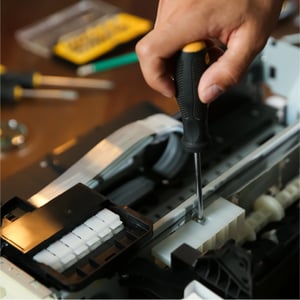90% of companies fail to track their printing costs, and that’s a big miss. Many businesses could reduce their printing expenditures by 10–30% if only they knew where their money was really going.
This infographic will walk you through the steps to calculating your print costs on your own, or you can find a link to our handy print costs calculator at the end of this blog!-1.jpg?width=1200&height=4068&name=Marco_Print_Cost_Infographic%20(1)-1.jpg)
How To Calculate Printing Costs
Calculating your current cost-per-print provides a starting point for your organization’s overall print costs for each copier. It will provide a snapshot of how much it costs you to print on each device, and it will provide a baseline for understanding how much your organization pays to print (on a daily, weekly, monthly, or annual basis, depending on your calculations).
The easiest way to determine your cost-per-print is to work with a print provider and install software on your network to track printing in real time. This method will also produce the most accurate results. The alternative option is to manually gather the information needed and do the math. Here’s how…
How to Calculate Your Cost Per Print in 8 Steps
1. Determine Your Yield-Per-Cartridge
Most manufacturers share their page yield figures on their website and, often, on the side of their toner cartridge packaging. Different page yield figures will be provided for black-and-white and color printing.
2. Determine the Price of Each Toner Cartridge
If you are calculating your exact cost-per-print, you will need to identify the cost of the cartridges you are using. You may need assistance from accounting or purchasing to obtain these details.
If you have difficulty obtaining this information, you can use average retail prices for the toner cartridges you use. You can find these figures on print manufacturers’ websites or office supply sites. Keep in mind that for full-color printing, you will need to know the cost of all cartridges: black, cyan, magenta, and yellow.
3. Calculate Your Cost-Per-Print
When you have gathered all of the above information, you can calculate your cost-per-print.
Black-and-white example:
Toner Cost Cartridge ÷ Page Yield = Cost-Per-Print
Assuming all color cartridges are the same price with equal page yields, you can determine the cost-per-print of one color cartridge (as done above) and simply multiply it by three to get your cost–per–print.
4. Factor in the Cost of Equipment
The base price of your printer is one of the expenses that make up your true cost of printing. This expense may be in the form of an initial purchase price, lease payment, or cost-per-page contract. Your accounting department and your print provider will have this information.
5. Add the Cost of Additional Supplies
Apart from ink and toner, you’re also spending money on paper and other printed media, staples, and other finishing supplies. Again, your accounting department or print provider will know how much these supplies are setting you back.
6. Include Service and Maintenance Costs
It’s tempting to hang on to older printers, but they often end up costing you more than you might think. Your true cost of printing should also include the cost of keeping up your equipment. Sometimes that old printer that doesn’t owe you anything anymore is actually a giant money pit in disguise.
7. Tally Your Employee Burden Rate
Employee burden rate is essentially the cost of paying your employees. Between paper jams, connectivity problems, replacing toner, and everything else, printer care can take up a lot of company time. And if your employees are tied up with a printer issue, that means they're unavailable in other areas.
Additionally, print-related issues can cause missed deadlines and employee frustration. While you won't find these issues itemized on a budget, they do affect your bottom line. If you have one employee who’s responsible for dealing with printer issues, they should know how many hours a week or a month they spend, on average, babysitting this equipment.
8. Account for the Lifecycle of Your Equipment
One final factor that makes up your true cost of printing is your printer’s lifespan. You can usually determine how many pages you can expect to get out of a printer. By knowing how many pages you print a month, you can get a good estimate of how long your printer will last.
Beyond how you use your equipment, the evolution of technology increases a printer's rate of depreciation.
Knowing your true cost of printing is an important first step in determining ways you can save. Once you've identified all these extra costs, you can determine areas for improvement. After all, you can't manage what you don't know!
Easy Ways To Reduce Printing Costs for Businesses
Once you know where your money is going, the next step is to use that information to make good decisions. Aside from some print cost-cutting basics, many companies have outsourced their print environment to a Managed Print Services (MPS) provider.
A good one can often help you cut your print costs by up to 30%, automate supply ordering, monitor print equipment to anticipate maintenance and repair needs, increase print security, and more. At Marco, we also provide a free print assessment, so you won’t have to do any of this math yourself.
But if you prefer a DIY solution, we created a handy Print Cost Calculator that will help you gather your necessary expenses and simply plug them in. Be our guest!

